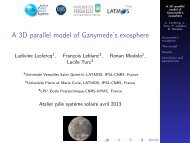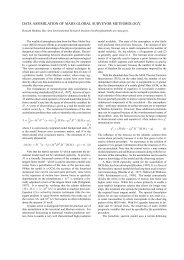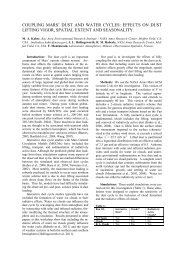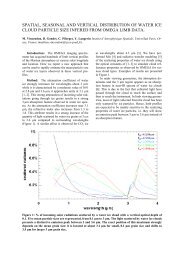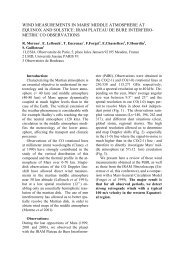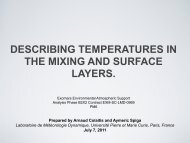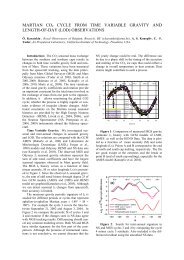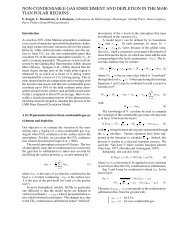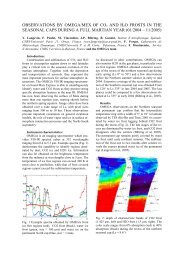MARS CLIMATE DATABASE v5.0 USER MANUAL - The Mars ...
MARS CLIMATE DATABASE v5.0 USER MANUAL - The Mars ...
MARS CLIMATE DATABASE v5.0 USER MANUAL - The Mars ...
Create successful ePaper yourself
Turn your PDF publications into a flip-book with our unique Google optimized e-Paper software.
procedure (which uses 32 pixels/degree MOLA topography) has been implemented to simulate localpressure and density as accurately as possible.Above the top level of the database density and pressure are estimated by integration of thehydrostatic equation assuming a constant temperature.For these variables, the subroutine delivers mean values and, if requested, adds a different typeof perturbation to density, pressure, temperature and winds. <strong>The</strong> available types of perturbation are :• Small scale perturbations due to the upward propagation of gravity waves for any altitudes(there is no small scale perturbation for surface pressure).• Large scale perturbations due to the motion of baroclinic weather systems and other transientwaves. <strong>The</strong>se perturbations are correlated in longitude and altitude, and are reconstructedfrom the actual system predicted by the model.• Perturbations equal to n times the RMS day to day variation for all variables.<strong>The</strong> two first types of perturbation have a random component. A comprehensive explanation ofthe perturbations is included in the Detailed Design Document 35.2 Software Package<strong>The</strong> call mcd subroutine is in directory mcd. This directory includes:• README, a short text file which summarizes the information contained here.• File call mcd.F, which contains the CALL MCD main subroutine and most of the subroutinesand functions it calls.• the include file constants mcd.inc used by call mcd and subsidiary routines.• File test mcd.F which contains a simple and straightforward illustration of a programusing call mcd and julian.3 In summary the perturbations are calculated as follow :• <strong>The</strong> gravity wave perturbation of a meteorological variable is calculated by considering vertical displacementsof the form( ) 2πzδz = δh sinλ + φ0 (1)where λ is a characteristic vertical wavelength for the gravity wave and φ 0 is a randomly generated surface phaseangle. surface angle. δz is the amplitude of the wave depending on the height z. δh is the sub-grid scale surfaceroughness (the variability on scales smaller than the explicit database resolution) and is a function of location onthe Martian surface. If z is higher than 100 km, the amplitude of the wave is taken to be equal to the amplitudeat 100 km.<strong>The</strong> amplitude of the wave is limited to λ/2/π to saturate the amplitude of the perturbation when itbecomes statically unstable.• <strong>The</strong> large scale perturbation in the <strong>Mars</strong> Climate Database is represented using a technique that is widely usedin meteorological data analysis, namely, Empirical Orthogonal Function (EOF) analysis. A two-dimensional,multivariate EOF of the main atmospheric variables (surface pressure, atmospheric temperature and windcomponents) is used which describes correlations in the model variability as a function of both height andlongitude. 200 EOFs have been retained in the series in order to reproduce the variability of the original fields.Above the top level of the database, the perturbation represents a constant percentage of the mean value thispercentage is equal to those at the top of the database.• For the last type of perturbation (i.e. n times the standard deviation), the standard deviation is interpolated fromthe day to day RMS variabilities stored in the database. If the user works with pressure as the vertical coordinate,then the added variabilities are pressure-wise, and altitude-wise otherwise. Above the top level of the database,the standard deviation represents a constant percentage of the mean value ; this percentage is equal to those at thetop of the database.8



